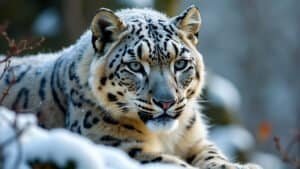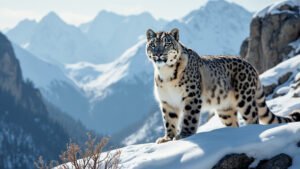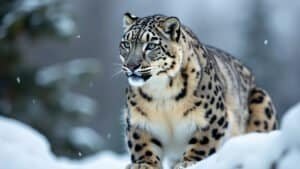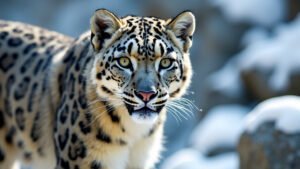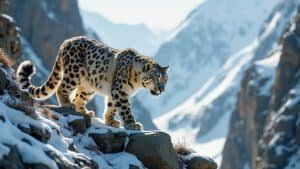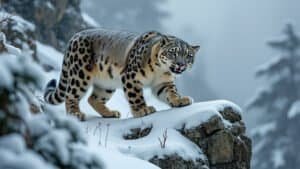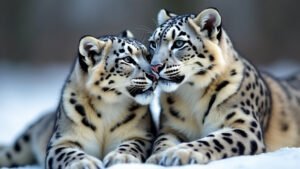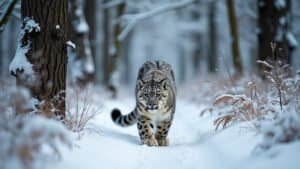Introduction
Snow leopards, the elusive big cats of the high mountains, have a fascinating evolutionary history. This article delves into their ancient ancestors, the adaptations that enabled them to thrive in frigid environments, and the divergence from other big cats
We will explore the unique genetic traits that set them apart, the geographical influences that shaped their evolution, and how they have evolved over the last million years. Join us on this journey to uncover the evolutionary origins of snow leopards
Ancient Ancestors of Snow Leopards
Snow leopards, scientifically known as Panthera uncia, are remarkable creatures with a lineage tracing back millions of years. Understanding their evolutionary origins requires delving into the broader family of big cats (Panthera), which includes lions, tigers, leopards, and jaguars
This section explores the evolutionary lineage of snow leopards, identifies key species in their ancestry, and examines the genetic markers that highlight their early development
Evolutionary Lineage of Big Cats
The family Felidae, to which snow leopards belong, is estimated to have originated about 25 million years ago during the Oligocene epoch
The big cats, including the genus Panthera, split from their smaller relatives around 6-10 million years ago. The genus Panthera is believed to have originated in Asia, with the earliest known big cat fossils found in the region
According to molecular studies, the most recent common ancestor of the Panthera lineage lived approximately 4.6 million years ago. The big cats then diversified, with lions (Panthera leo), tigers (Panthera tigris), and other large cats following distinct evolutionary paths
Snow leopards are thought to have diverged from the other Panthera species about 4 million years ago, based on genetic evidence and fossil records
Key Species in Snow Leopard Ancestry
One of the key ancestors of the modern snow leopard is the extinct species Panthera blytheae. Fossils of Panthera blytheae, dating back around 4.1 to 5.9 million years, were discovered in the Tibetan Plateau
This discovery, made in 2010, provided crucial insights into the early evolutionary history of snow leopards. The high-altitude fossils suggest that the ancestors of snow leopards were already adapted to life in mountainous regions, hinting at their evolutionary response to environmental pressures
Another significant species in snow leopard ancestry is Panthera palaeosinensis, which lived in China around 2 to 3 million years ago. This species is considered a close relative and possibly a direct ancestor of the snow leopard. The physical and genetic characteristics of Panthera palaeosinensis show many similarities to modern snow leopards, indicating a gradual adaptation process to high-altitude habitats
Genetic Markers of Early Snow Leopards
Genetic research has been instrumental in tracing the evolutionary history of snow leopards. Studies focusing on mitochondrial DNA (mtDNA) have revealed significant information about their divergence and adaptation
Mitochondrial DNA analysis has shown that snow leopards possess unique genetic markers that differentiate them from other Panthera species. These markers are linked to adaptations for survival in cold and hypoxic (low oxygen) environments
One notable genetic adaptation is found in the EPAS1 gene, which plays a crucial role in the response to low oxygen levels at high altitudes. Variants of this gene are also found in Tibetan humans, indicating a parallel evolutionary adaptation to similar environmental challenges. This genetic evidence supports the idea that snow leopards evolved specific traits to thrive in mountainous regions
In addition to mitochondrial DNA, nuclear DNA studies have provided a more comprehensive understanding of snow leopard evolution. Whole-genome sequencing has identified specific genetic variants associated with thick fur, robust limbs, and nasal adaptations, all of which are essential for survival in their harsh, cold habitat
Adaptations to Cold Environments
Snow leopards are renowned for their ability to thrive in some of the harshest environments on Earth. Their adaptations to cold, high-altitude regions are a testament to the power of evolution in shaping species to suit their habitats
This section explores the physical, behavioral, and genetic adaptations that enable snow leopards to survive in such extreme conditions
Physical Adaptations
Snow leopards possess several physical traits that are crucial for their survival in cold environments. One of the most prominent features is their thick fur, which provides insulation against freezing temperatures
Their fur is dense and woolly, with long guard hairs that protect against wind and snow. The underfur is softer and traps air, providing excellent thermal insulation
Their large, powerful paws act like snowshoes, distributing their weight more evenly and allowing them to walk on snow without sinking. These paws are also covered in fur, which helps to keep them warm and provides extra traction on icy surfaces
Additionally, the snow leopard’s long, muscular tail aids in maintaining balance while navigating rocky, uneven terrain. The tail also serves as a blanket that the snow leopard can wrap around its body and face for additional warmth during rest
Behavioral Adaptations
Behavioral adaptations play a crucial role in the snow leopard’s ability to survive in cold environments. These solitary animals are highly territorial and have large home ranges, which they patrol to find prey and mark their territory with scent markings
Snow leopards are crepuscular, meaning they are most active during dawn and dusk, which helps them conserve energy and avoid the heat of the day and the extreme cold of night
Their hunting strategies are also adapted to their environment. Snow leopards are ambush predators, relying on stealth and surprise to catch their prey. They use the rocky and snowy terrain to their advantage, stalking their prey from above and making a sudden, powerful leap to capture it
This hunting technique minimizes energy expenditure and increases their chances of a successful kill in a landscape where prey can be scarce
Snow leopards are also opportunistic feeders, meaning they will eat whatever prey is available, including ibex, blue sheep, marmots, and smaller mammals. This dietary flexibility is crucial for survival in an environment where food sources can be unpredictable and widely dispersed
Genetic Adaptations
Genetic adaptations have equipped snow leopards with unique traits that enhance their ability to live in high-altitude, cold environments. One of the key genetic adaptations is in the hypoxia-inducible factor (HIF) pathway, which regulates the body’s response to low oxygen levels
Snow leopards have specific variations in the EPAS1 gene, part of the HIF pathway, that allow them to cope with hypoxia, a common challenge in high-altitude regions. This adaptation is similar to the genetic changes observed in high-altitude human populations, such as Tibetans
Additionally, snow leopards have genetic adaptations related to their metabolism. Studies have shown that they have evolved to efficiently utilize their fat stores, providing a crucial energy source during times when prey is scarce. This metabolic efficiency helps them survive long periods without food, a common occurrence in their harsh environment
Other genetic adaptations include those related to their fur and body size. Snow leopards have genes that regulate fur growth and density, ensuring they have the thick, insulating coat necessary for cold climates
They also have adaptations that contribute to their relatively small size compared to other big cats, which is beneficial for heat retention and navigating rugged, mountainous terrain
Divergence from Other Big Cats
Snow leopards, like all modern big cats, share a common ancestor that lived millions of years ago. However, they have undergone significant evolutionary changes that distinguish them from their closest relatives
This section will delve into the timeline of divergence, compare the genetics of snow leopards with other big cats, and highlight key evolutionary milestones
Timeline of Divergence
The divergence of snow leopards from other big cats is a key event in their evolutionary history
According to genetic studies, the common ancestor of all big cats, including snow leopards, lions, tigers, leopards, and jaguars, existed around 6-10 million years ago. The genus Panthera is believed to have split from this ancestor approximately 6 million years ago
Snow leopards are thought to have diverged from the common ancestor of Panthera species around 4 million years ago. This timeline is supported by both fossil evidence and molecular data
Fossils of early big cats, such as Panthera blytheae, which show traits similar to snow leopards, have been found in the Tibetan Plateau, dating back to about 4.1 to 5.9 million years ago. This indicates that snow leopards began to adapt to high-altitude, mountainous environments early in their evolutionary history
Comparative Genetics
Comparative genetic studies have provided significant insights into the divergence of snow leopards from other big cats. DNA sequencing has revealed that snow leopards have several unique genetic traits that differentiate them from their closest relatives
One of the key differences lies in their mitochondrial DNA (mtDNA). Mitochondrial DNA, which is inherited maternally, shows distinct variations in snow leopards compared to other Panthera species. These variations are linked to adaptations for high-altitude living, such as efficient oxygen utilization and energy metabolism
In addition to mtDNA, nuclear DNA studies have identified specific genes that are unique to snow leopards
For example, genes related to fur density and color, which are crucial for camouflage and insulation in snowy environments, differ significantly from those in lions or tigers. These genetic differences are the result of evolutionary pressures specific to the cold, mountainous regions that snow leopards inhabit
Evolutionary Milestones
Several key evolutionary milestones have shaped the development of snow leopards as a distinct species. One of the earliest milestones was the adaptation to high-altitude environments
The discovery of Panthera blytheae fossils in the Tibetan Plateau suggests that early snow leopard ancestors were already living in mountainous areas millions of years ago. This adaptation likely involved changes in physiology and behavior to cope with cold temperatures and low oxygen levels
Another significant milestone was the development of specialized hunting techniques. As ambush predators, snow leopards evolved to rely on stealth and surprise to catch their prey. This involved not only physical adaptations, such as powerful hind legs for leaping, but also behavioral changes, such as developing a keen sense of timing and patience
The Pleistocene epoch, which began about 2.6 million years ago, brought about dramatic climate changes that further influenced snow leopard evolution. During this time, glacial and interglacial periods caused significant shifts in habitat and prey availability
Snow leopards adapted to these changes by becoming more opportunistic feeders and expanding their range to include a variety of mountainous regions across Central and South Asia
Unique Genetic Traits
Snow leopards possess a range of unique genetic traits that distinguish them from other big cats and enable them to thrive in their specific environment. This section explores DNA sequencing studies, specific genetic adaptations, and comparative analysis with their closest relatives
DNA Sequencing Studies
DNA sequencing has been crucial in uncovering the unique genetic makeup of snow leopards. Whole-genome sequencing has allowed scientists to identify specific genes that are responsible for their distinct adaptations
One of the most significant findings from these studies is the identification of genes involved in hypoxia response, fur characteristics, and metabolism
For instance, a study published in Nature Communications in 2014 revealed that snow leopards have a distinct variation of the EPAS1 gene, which plays a critical role in adapting to low oxygen levels found at high altitudes
This gene variation is also found in Tibetan humans and is associated with enhanced oxygen transport and utilization in hypoxic conditions
Specific Genetic Adaptations
Snow leopards exhibit several specific genetic adaptations that have evolved to help them survive in their harsh, mountainous environments. These adaptations are evident in their physical characteristics, physiology, and behavior:
Hypoxia Tolerance
The EPAS1 gene variation mentioned above is a key adaptation for living at high altitudes. This gene helps regulate the body’s response to low oxygen levels, allowing snow leopards to efficiently utilize available oxygen and maintain energy levels despite the thin air
Fur Density and Color
Genetic adaptations related to fur density and coloration are essential for insulation and camouflage. Snow leopards have evolved to have a thick, dense coat that provides warmth in cold environments. The coloration of their fur, with its pale base and dark rosettes, offers excellent camouflage against the rocky, snowy terrain, helping them to ambush prey and avoid detection
Metabolic Efficiency
Genes associated with metabolic processes have also adapted to the snow leopard’s environment. Snow leopards can efficiently metabolize fat, which is crucial during periods when prey is scarce. This metabolic efficiency ensures that they can survive long periods without food, a common challenge in their habitat
Comparative Analysis with Relatives
Comparing the genetic makeup of snow leopards with their closest relatives, such as tigers, leopards, and lions, highlights the unique adaptations that have evolved in response to their specific environment:
Tigers
Tigers (Panthera tigris) and snow leopards share a common ancestor, but their evolutionary paths diverged millions of years ago. Tigers, which primarily inhabit dense forests and grasslands, do not have the same adaptations for high-altitude living
For example, tigers lack the specific hypoxia-related genetic variations found in snow leopards. Their fur is also different, with tigers having less dense coats compared to the insulating fur of snow leopards
Leopards
Leopards (Panthera pardus) are more adaptable in terms of habitat, ranging from savannas to forests. However, they do not possess the specialized adaptations for extreme cold and high altitudes seen in snow leopards
Genetic comparisons show that leopards lack certain metabolic and hypoxia-related genes that are crucial for snow leopards
Lions
Lions (Panthera leo) are adapted to the open grasslands and savannas of Africa. They have evolved to thrive in warmer climates and social structures that differ significantly from the solitary nature of snow leopards
The genetic differences between lions and snow leopards reflect their distinct evolutionary pressures and environments
Geographical Influences
The geographical distribution and features of snow leopards’ habitats have played a significant role in shaping their evolution. This section will explore the role of mountain ranges, migration patterns, and habitat specialization in the development of snow leopards
Role of Mountain Ranges
Snow leopards are primarily found in the mountainous regions of Central and South Asia, including the Himalayas, the Tibetan Plateau, the Altai Mountains, and the Tien Shan range. These mountain ranges provide the rugged terrain and cold climate that snow leopards are well adapted to
The isolation of these mountain ranges has led to the development of distinct snow leopard populations
Each mountain range offers a unique environment that has influenced the physical and behavioral adaptations of the snow leopards living there. For example, snow leopards in the Himalayas might face different environmental pressures compared to those in the Altai Mountains, leading to slight variations in their adaptations
The geographical barriers created by mountain ranges have also contributed to the genetic diversity within snow leopard populations
Limited gene flow between isolated populations can lead to genetic differentiation, which may result in unique adaptations to local environments. This geographical isolation is a key factor in the evolution of snow leopards as a species distinct from other big cats
Migration Patterns
The migration patterns of snow leopards have been influenced by both natural and anthropogenic factors. Historically, snow leopards likely migrated across large areas in search of prey and suitable habitats
These migrations would have been facilitated by the connectedness of mountain ranges and high-altitude plateaus
In recent times, human activities such as habitat fragmentation, poaching, and climate change have affected the migration patterns of snow leopards. Fragmented habitats can restrict the movement of snow leopards, leading to isolated populations that are more vulnerable to genetic bottlenecks and reduced genetic diversity
Conservation efforts are now focused on creating wildlife corridors to reconnect fragmented habitats and allow for the natural movement of snow leopards
Habitat Specialization
Snow leopards have specialized in living in harsh, high-altitude environments, which has influenced their physical and behavioral traits. Their habitat specialization includes adaptations to cold climates, rugged terrain, and scarce prey availability:
Cold Climate Adaptations
Snow leopards are well adapted to the cold climates of their mountainous habitats. Their thick fur provides insulation against freezing temperatures, and their large paws act as snowshoes, distributing their weight and preventing them from sinking into the snow. These physical adaptations are essential for survival in their cold, high-altitude environment
Rugged Terrain Navigation
The rugged terrain of mountain ranges requires snow leopards to be agile and sure-footed. Their powerful hind legs and long tails help them maintain balance while navigating steep, rocky slopes. This agility is crucial for hunting prey in such challenging terrain
Prey Availability
Prey availability in snow leopard habitats can be scarce and unpredictable. Snow leopards have adapted to this by becoming opportunistic feeders, capable of hunting a variety of prey species, including blue sheep, ibex, marmots, and smaller mammals. Their hunting strategy involves stalking prey from above and making a sudden leap, using the element of surprise to their advantage
Low Oxygen Levels
The high-altitude environments where snow leopards live have lower oxygen levels. Snow leopards have adapted to this challenge through genetic changes that enhance their ability to utilize oxygen efficiently. The variation in the EPAS1 gene, which is associated with hypoxia tolerance, is a crucial adaptation for survival at high altitudes
Evolution Over the Last Million Years
The evolution of snow leopards over the last million years has been influenced by a variety of environmental changes, climatic fluctuations, and adaptations to their prey and habitat
This section will delve into the fossil record findings, environmental changes, and population dynamics that have shaped the modern snow leopard
Fossil Record Findings
Fossil records provide invaluable insights into the evolutionary history of snow leopards
The discovery of Panthera blytheae fossils, which date back around 4.1 to 5.9 million years, in the Tibetan Plateau has shed light on the early ancestors of snow leopards. These fossils suggest that the snow leopard lineage has long been adapted to high-altitude, mountainous environments
Other significant fossil finds include those of Panthera uncia (the modern snow leopard) and closely related species. These fossils have been found in various parts of Central Asia, including Mongolia and Siberia, and date back to the Pleistocene epoch, which began around 2.6 million years ago
These findings indicate that snow leopards have been present in their current range for a significant period and have undergone evolutionary changes in response to climatic and environmental shifts
Environmental Changes
The Pleistocene epoch was characterized by repeated glacial and interglacial periods, which had a profound impact on the habitats and evolution of snow leopards
During glacial periods, the expansion of ice sheets and colder temperatures would have pushed snow leopards to lower altitudes and more southerly regions. Conversely, interglacial periods would have allowed them to recolonize higher altitudes as the ice receded
These climatic fluctuations would have driven changes in prey availability and habitat conditions, forcing snow leopards to adapt continually. The ability to survive in a range of altitudes and conditions likely contributed to the development of their versatile hunting strategies and physical adaptations
Population Dynamics
The population dynamics of snow leopards over the last million years have been influenced by both natural and anthropogenic factors. Historical population sizes and distributions would have fluctuated in response to climatic changes, prey availability, and habitat conditions
Genetic studies suggest that snow leopards have maintained a relatively stable population size over time, despite the challenges posed by their environment
However, in more recent history, human activities have had a significant impact on snow leopard populations. Habitat loss due to agricultural expansion, poaching, and climate change are major threats to their survival. Fragmented habitats and reduced prey availability have led to declining populations in many areas
Conservation efforts are now focused on mitigating these threats and ensuring the long-term survival of snow leopards
These efforts include anti-poaching measures, habitat restoration, and community-based conservation programs that involve local populations in the protection of snow leopards and their habitats
Conclusion
The evolutionary origins of snow leopards reveal a rich history marked by adaptation and survival in some of the world’s most challenging environments. Tracing back to ancient ancestors like Panthera blytheae, snow leopards have evolved distinct traits to thrive in cold, high-altitude habitats
Physical, behavioral, and genetic adaptations such as thick fur, large paws, hypoxia tolerance, and efficient metabolism have been key to their survival. Their divergence from other big cats millions of years ago highlights their unique evolutionary path shaped by geographical isolation and environmental pressures
Understanding these evolutionary milestones and the influences of mountain ranges, migration patterns, and climatic changes is crucial for their conservation. As we continue to study and protect these majestic creatures, we gain valuable insights into the intricate connections between species and their ecosystems




